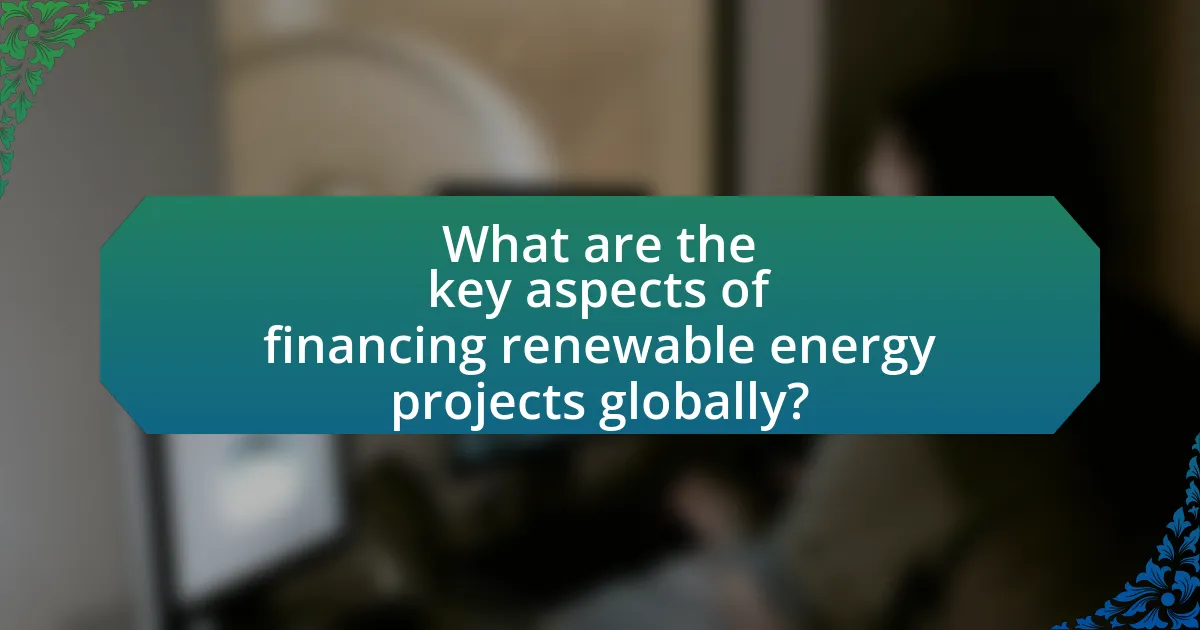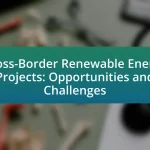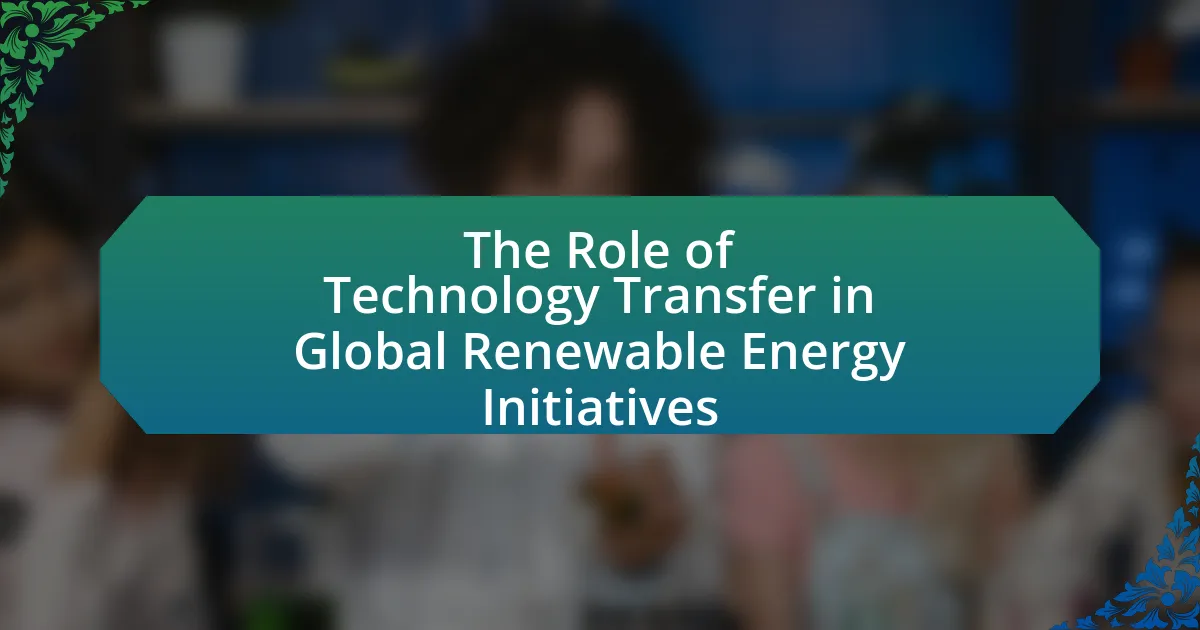The article focuses on financing renewable energy projects globally, highlighting key aspects such as access to capital, government incentives, risk management, and innovative financing mechanisms. It examines various funding sources, including public grants, private investments, bank loans, and crowdfunding, and discusses the differences between public and private investments in terms of risk and objectives. The article also addresses the challenges faced by renewable energy projects without adequate financing, the impact of financing on scalability, and the role of international organizations in supporting these initiatives. Additionally, it explores emerging financing tools like green bonds and crowdfunding, best practices for attracting investors, and strategies for mitigating financial risks in renewable energy projects.

What are the key aspects of financing renewable energy projects globally?
The key aspects of financing renewable energy projects globally include access to capital, government incentives, risk management, and innovative financing mechanisms. Access to capital is crucial, as it determines the ability to fund projects; for instance, the International Renewable Energy Agency reported that global investment in renewable energy reached $282.2 billion in 2019. Government incentives, such as tax credits and subsidies, play a significant role in attracting investment by reducing upfront costs. Risk management strategies, including insurance and guarantees, help mitigate financial uncertainties associated with renewable energy projects. Additionally, innovative financing mechanisms, such as green bonds and crowdfunding, have emerged to diversify funding sources and engage a broader range of investors. These aspects collectively enhance the viability and attractiveness of renewable energy investments on a global scale.
How do different funding sources contribute to renewable energy financing?
Different funding sources significantly contribute to renewable energy financing by providing the necessary capital for project development, operational costs, and technological advancements. Public funding, such as government grants and subsidies, incentivizes investments in renewable technologies, while private investments from venture capital and private equity firms drive innovation and scalability. Additionally, multilateral development banks and international financial institutions offer loans and guarantees that reduce risk for investors, facilitating larger projects. For instance, the International Renewable Energy Agency reported that global investment in renewable energy reached $282 billion in 2019, highlighting the critical role of diverse funding sources in supporting the transition to sustainable energy systems.
What are the main types of funding sources available for renewable energy projects?
The main types of funding sources available for renewable energy projects include government grants, private investments, bank loans, and crowdfunding. Government grants often provide financial support without the expectation of repayment, incentivizing the development of renewable technologies. Private investments, including venture capital and equity financing, enable startups and established companies to scale their projects. Bank loans offer a traditional financing route, where financial institutions lend capital based on project viability and expected returns. Crowdfunding platforms allow individuals to contribute small amounts of money to support specific renewable energy initiatives, democratizing investment opportunities. These funding sources collectively facilitate the growth and implementation of renewable energy projects globally.
How do public and private investments differ in renewable energy financing?
Public and private investments in renewable energy financing differ primarily in their sources of capital and risk tolerance. Public investments typically come from government funding, grants, and subsidies aimed at promoting clean energy initiatives, often with a focus on long-term societal benefits and environmental goals. For instance, the U.S. government allocated approximately $29 billion in renewable energy tax incentives in 2020, demonstrating its commitment to fostering the sector. In contrast, private investments are driven by profit motives, with investors seeking returns on their capital, which can lead to a preference for projects with quicker payback periods and lower perceived risks. According to a report by Bloomberg New Energy Finance, global investment in renewable energy reached $501 billion in 2020, with a significant portion coming from private sources, highlighting the critical role of private capital in scaling renewable technologies.
Why is financing crucial for the success of renewable energy projects?
Financing is crucial for the success of renewable energy projects because it provides the necessary capital to develop, implement, and maintain these initiatives. Without adequate funding, projects may face delays, reduced scale, or even cancellation, hindering the transition to sustainable energy sources. For instance, a report by the International Renewable Energy Agency (IRENA) indicates that global investment in renewable energy must reach $2 trillion annually by 2030 to meet climate goals. This financial support enables the acquisition of technology, infrastructure development, and operational costs, ensuring that projects can deliver reliable energy and achieve long-term sustainability.
What challenges do renewable energy projects face without adequate financing?
Renewable energy projects face significant challenges without adequate financing, including project delays, inability to scale operations, and increased reliance on fossil fuels. Insufficient funding can lead to stalled development timelines, as projects often require substantial upfront capital for technology, infrastructure, and regulatory compliance. For instance, a report by the International Renewable Energy Agency (IRENA) highlights that inadequate financing can result in a 30% increase in project costs due to delays and missed opportunities for economies of scale. Furthermore, without financial support, projects may struggle to secure necessary technology and expertise, ultimately hindering the transition to sustainable energy sources and perpetuating dependence on traditional energy systems.
How does financing impact the scalability of renewable energy initiatives?
Financing significantly impacts the scalability of renewable energy initiatives by providing the necessary capital for project development and expansion. Access to adequate funding enables the deployment of advanced technologies, infrastructure development, and operational scaling, which are crucial for meeting growing energy demands. For instance, according to the International Renewable Energy Agency (IRENA), global investments in renewable energy reached $2.6 trillion from 2010 to 2019, demonstrating that increased financial support correlates with accelerated project implementation and capacity growth. Furthermore, financing mechanisms such as green bonds and public-private partnerships facilitate risk-sharing and attract diverse investors, thereby enhancing the scalability of renewable energy projects.
What role do international organizations play in funding renewable energy projects?
International organizations play a crucial role in funding renewable energy projects by providing financial resources, technical assistance, and policy guidance. These organizations, such as the World Bank and the International Renewable Energy Agency (IRENA), mobilize investments through grants, loans, and guarantees, facilitating the development of sustainable energy infrastructure. For instance, the World Bank has committed billions of dollars to renewable energy initiatives, supporting projects that aim to increase access to clean energy in developing countries. This funding not only helps to reduce greenhouse gas emissions but also promotes economic growth and energy security, demonstrating the significant impact of international organizations in advancing global renewable energy goals.
Which international organizations are most active in renewable energy financing?
The most active international organizations in renewable energy financing include the World Bank, the International Renewable Energy Agency (IRENA), and the Asian Development Bank (ADB). The World Bank has committed over $20 billion to renewable energy projects since 2010, focusing on sustainable development and poverty reduction. IRENA supports countries in their transition to renewable energy through various financial mechanisms and has facilitated investments exceeding $1 trillion globally. The ADB has invested around $3 billion annually in renewable energy projects across Asia, emphasizing clean energy access and climate resilience. These organizations play crucial roles in mobilizing funds and providing technical assistance for renewable energy initiatives worldwide.
How do these organizations influence global renewable energy policies?
Organizations influence global renewable energy policies by advocating for sustainable practices, providing funding, and shaping regulatory frameworks. For instance, the International Renewable Energy Agency (IRENA) promotes the adoption of renewable energy technologies through policy guidance and capacity building, which helps countries develop their energy strategies. Additionally, the World Bank offers financial support and technical assistance for renewable energy projects, thereby encouraging nations to invest in clean energy solutions. These actions are supported by data showing that countries with strong institutional frameworks and financial backing from such organizations tend to have higher rates of renewable energy adoption, as evidenced by the increase in renewable energy capacity in developing nations receiving support from these entities.
How can stakeholders effectively navigate the renewable energy financing landscape?
Stakeholders can effectively navigate the renewable energy financing landscape by leveraging diverse funding sources, understanding regulatory frameworks, and engaging with financial institutions. Utilizing a mix of public and private financing options, such as government grants, green bonds, and venture capital, allows stakeholders to optimize their capital structure. Familiarity with local and international regulations, including incentives like tax credits and feed-in tariffs, enhances their ability to secure funding. Additionally, building relationships with banks and investors who specialize in renewable energy can facilitate access to necessary capital. According to the International Renewable Energy Agency (IRENA), global investment in renewable energy reached $300 billion in 2020, highlighting the growing financial support for these projects.
What innovative financing mechanisms are emerging in the renewable energy sector?
Innovative financing mechanisms emerging in the renewable energy sector include green bonds, crowdfunding, and power purchase agreements (PPAs). Green bonds are debt instruments specifically earmarked for funding environmentally friendly projects, with the global green bond market reaching over $1 trillion in issuance by 2021, demonstrating significant investor interest. Crowdfunding platforms allow individuals to invest in renewable energy projects, democratizing access to capital and enabling smaller projects to secure funding. Power purchase agreements provide long-term contracts between energy producers and consumers, ensuring stable revenue streams for renewable energy projects, which has led to increased investment in solar and wind energy. These mechanisms collectively enhance the financial viability of renewable energy initiatives, driving growth in the sector.
How do green bonds function as a financing tool for renewable energy projects?
Green bonds function as a financing tool for renewable energy projects by providing capital specifically earmarked for environmentally sustainable initiatives. These bonds are issued by governments, corporations, or financial institutions to raise funds that are exclusively used for projects such as solar, wind, and hydroelectric energy developments. According to the Climate Bonds Initiative, the global green bond market reached over $1 trillion in issuance by 2021, demonstrating significant investor interest in financing renewable energy. This dedicated funding mechanism not only attracts environmentally conscious investors but also helps lower the cost of capital for renewable energy projects, making them more financially viable.
What role do crowdfunding platforms play in supporting renewable energy initiatives?
Crowdfunding platforms play a crucial role in supporting renewable energy initiatives by providing an accessible funding mechanism for projects that may struggle to secure traditional financing. These platforms enable individuals and organizations to raise capital directly from the public, allowing for diverse investment opportunities in solar, wind, and other renewable energy projects. For instance, according to a report by the Cambridge Centre for Alternative Finance, crowdfunding for renewable energy projects has grown significantly, with over $1 billion raised globally in 2019 alone. This growth demonstrates the effectiveness of crowdfunding in mobilizing financial resources for sustainable energy solutions, fostering innovation, and increasing public engagement in the transition to renewable energy.
What best practices should be followed for successful renewable energy project financing?
Successful renewable energy project financing requires a comprehensive approach that includes thorough feasibility studies, strong stakeholder engagement, and diversified funding sources. Conducting detailed feasibility studies ensures that projects are economically viable and technically sound, which is crucial for attracting investors. Engaging stakeholders, including local communities and government entities, fosters support and mitigates potential opposition, enhancing project sustainability. Diversifying funding sources, such as combining equity, debt, and grants, reduces financial risk and increases the likelihood of securing necessary capital. These practices are supported by industry reports indicating that projects adhering to these strategies have higher success rates in securing financing and achieving operational goals.
How can project developers attract more investors for renewable energy projects?
Project developers can attract more investors for renewable energy projects by demonstrating the financial viability and long-term sustainability of their initiatives. This can be achieved through comprehensive feasibility studies that outline projected returns on investment, risk assessments, and market analysis. For instance, according to the International Renewable Energy Agency (IRENA), the global renewable energy sector has seen a consistent increase in investment, reaching $282 billion in 2019, indicating strong market potential. Additionally, leveraging government incentives and subsidies can enhance project attractiveness, as many countries offer financial support for renewable energy initiatives. By showcasing successful case studies and partnerships with established firms, project developers can build credibility and trust, further enticing investors.
What strategies can be implemented to mitigate financial risks in renewable energy projects?
To mitigate financial risks in renewable energy projects, developers can implement strategies such as diversifying funding sources, securing long-term power purchase agreements (PPAs), and utilizing financial instruments like insurance and hedging. Diversifying funding sources reduces reliance on a single investor or financial institution, thereby spreading risk. Long-term PPAs provide revenue certainty by locking in prices for energy sales, which enhances project bankability. Additionally, financial instruments such as insurance can protect against unforeseen events, while hedging can manage price volatility in energy markets. These strategies are supported by industry practices, as evidenced by the increasing adoption of PPAs in the renewable sector, which have been shown to stabilize cash flows and attract investment.




